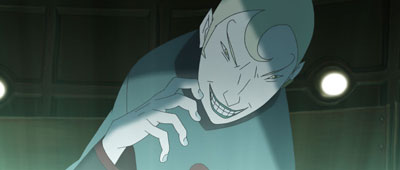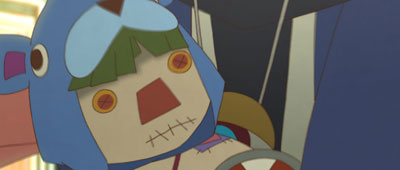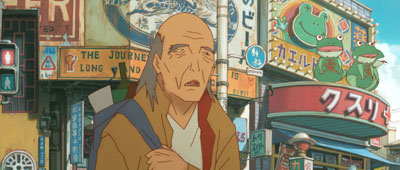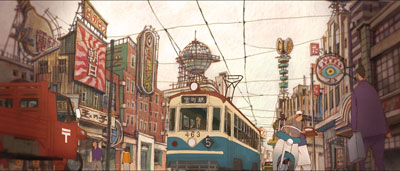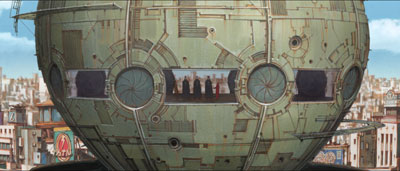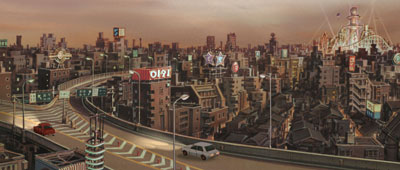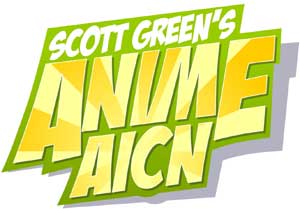 Logo handmade by Bannister
Column by Scott Green
Logo handmade by Bannister
Column by Scott Green
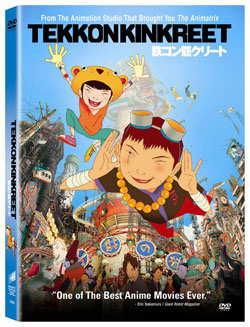
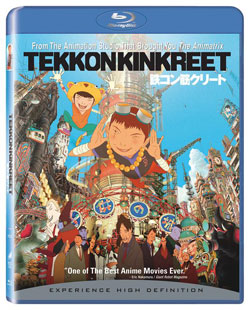
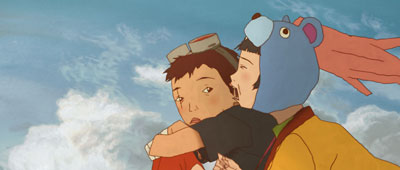
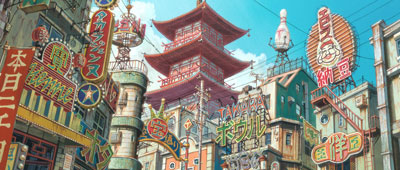
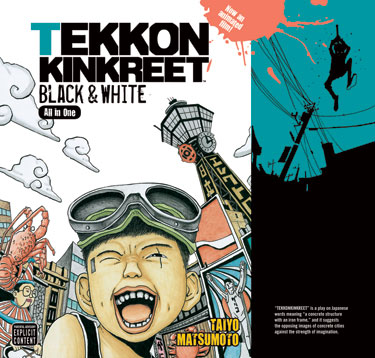
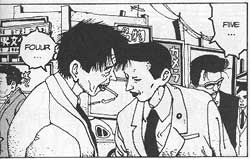
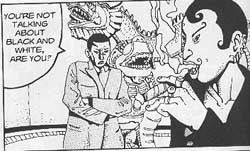
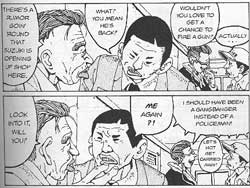








10/15/05 Update
And the winners are...
Adam Tierney
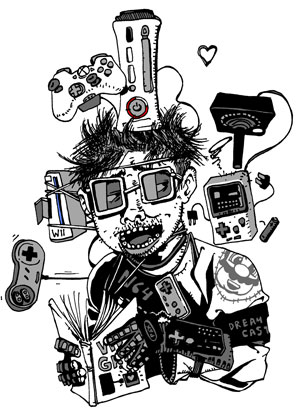
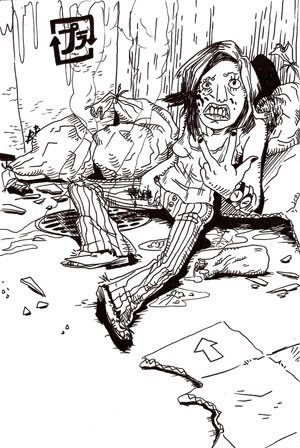
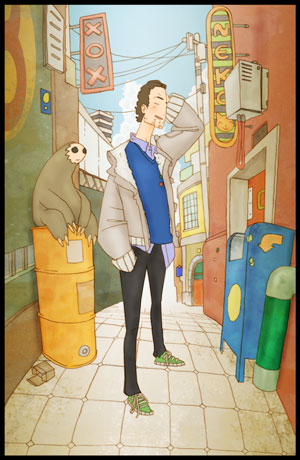
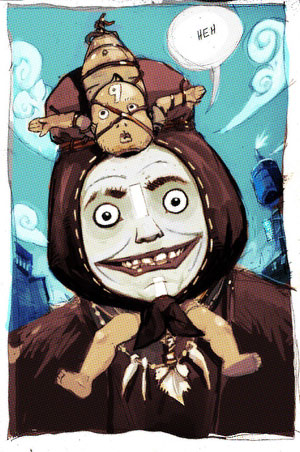
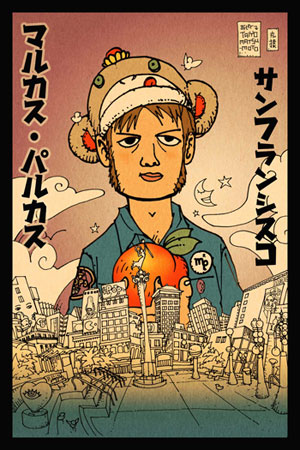





Tekkon Kinkreet Itself...
First, to get the unavoidable topics of conversation out of the way: 1) "tekkon kinkreet" or tekkonkinkreet is a word play referring to iron reinforced concrete. The term evokes the notions of hard cityscapes and muscle. As one character muddles his ancient history "cities have been cold since Hammurabi built Babylon." 2) The movie is directed by Michael Arias, an animator who worked on the effects for James Cameron's The Abyss, who wrote software used in the making of Princess Mononoke and produced the Animatrix. Its script was written by Anthony Weintraub. Yes, anime written and directed by Americans are as common has hen's teeth, but Masaaki Yuasa (Mind Game), Mamoru Hosoda (The Girl Who Leapt Through Time) and even Satoshi Kon are hardly conventional anime directors either. If there really is a North American audience who objects to a Arias directed film being called "anime", then they haven't vocally raised the issue as a point of debate. But given the passion and craft evidently brought to bear on Tekkon Kinkreet, it's not even an interesting non-contraversy. The creative back-story behind the movie involves the better part of a decade of development and preparation. There were definitely influential collaborators involved in the animation of Tekkon Kinkreet. The multiple story board artists left their mark, including Shoujirou Nishimi, who also served as character designer and animation director. As did Shinji Kimura (art director for Steamboy, Background artist for Akira, and Angel's Egg, and Catnapped). Yet, the movie acts like the work of an auteur. It conforms to a specific artistic vision rather than simply a net cast, hoping to reel in eyes.The manga by Taiyo Matsumoto, from which the anime movie was adapted, was originally published by Viz in North America as "Black and White" (the new omnibus edition goes back to the phonetic "Tekkon Kinkreet"). The binary heroes of the piece are literally Kuro, "Black" and Shiro, "White. The movie's Black frequently appears in a t-shirt emblazoned with the number "96" on its back. If you think of the shape a yin-yang circle would make if its tear drop stood back to back rather than joined, the notion suggested the "96" captures the spirit of Black and White. Black has been sharpened to a razor edge by the city in which the pair live. Before they are shattered, Black is often seen with a pair of red goggles. At times, they are up on his crown, but frequently, he has them over his eyes; literally seeing red as he violently protects his turf. White is his inverse. While the eleven year old can barely count to ten, bathe or dress himself, unlike Black, or many adults, he can see beyond the confines of the city and maintain a vision of hope. From a tooth and nail perspective, the pair of orphans have thrived in the hard district of Treasure Town. The forces on the ground such as cops, gangs, yakuza, have at least a grudging respect for the "Cats" who swoop down from the roof tops to issue lead-pipe enforced justice. The movie opens with a gangster with an odious reputation known as "The Rat" returning to his Treasure Town turf. As the Rat begins muscling street gangs off the scene, his representatives, namely his protégé Kimura, begin exchanging new scars with the Cats. Yet, what looks to be developing into a nasty vigilante on gangster dust-up metastasizes into something more critical with the introduction of an "alien" interest who'd like to do a Giuliani on Treasure Town. The anti-sentiment "Snake"'s first steps in ensuring that those who might frequent the lucrative real-estate would not have to shuffle past Yakuza run strip clubs are to build a Kiddie Kastle amusement park, and eliminate nuisance elements like The Cats. 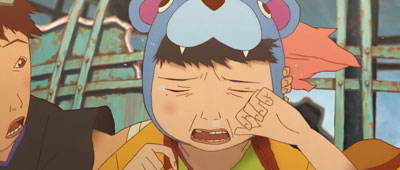
The cover for Viz's manga omnibus features Black roaring or open mouthed smiling. One gets the impression that there isn't much difference. He has a scar across one eye and a bandage next to the other. Clearly, he's someone with a long and a recent history of fighting. An essential aspect of Matsumoto's original manga is that punk Batman side to the story. Its opening pages stake out Black and White's credentials as a threat. Black stands on a utility pole, raven on his shoulder, ready to issue vigilante justice; White walks the street with snot running down his nose, but still ready to kick and club out a few teeth. These fights are ugly and brutal, but there is still plenty of testosterone involved. Even if Tekkon Kinkreet is not a traditional fight manga, there was the implicit promise "read this and you'll get to see Black hurt people." The anime does not operate like that. Any loose expectations for Tekkon Kinkreet as an action movie are bound to be disappointed. The spring board of the manga's second volume is the Cats show down with would-be opposite numbers, the Dawn and Dusk Brothers. Mid-chase, it's kids being kids with the city as their playground and Matsumoto's storytelling captures all the impact and velocity of the situation. The anime repositions this as a introduction, but the starker difference is that the source of awe is not the sight of these characters hanging off moving motor vehicles or tangling in mid-air acrobatics. For the anime, the spectacle is the scope and nature of the city that the impromptu tour reveals. In the anime, it's violence rather than action and it runs at a different meter than the physical engagements of most anime. The act of on one person moving to injure another is not timed for or staged for the thrill. As Shattering and screaming strip the appeal of the excitement, motion is captured rather than showcased. There is a scene in which a character clubs a foe with a rod, then pops off a cap on one of its ends to unsheathe a lethal spike, and does so with a Léon, The Professional dispassionate second nature efficiency. Yet, the reaction is not "damn, that guy's smooth". It's more like a snake striking in a nature documentary. Yes, it is impressive, but it wasn't done for your benefit. This approach follows through to a redesign of a number of secondary characters. The Cats are still the Cats. The Rat is the Rat. The Snake is the Snake, but his assassins are made more alien than foreign. Kimura is not softened, so much as he is turned from a movie Yakuza whose features plainly state "Yakuza" to a man who lives the Yakuza life style. He has the hair, the suit, and the scars to show it, but he no longer looks genetically "Yakuza." The bit part of the police detectives Fujimura and Sawada is largely reduced by the movie, and their impotent potential for action becomes a complete non-starter. Both are dumpier. The notion of Fujimura's illustrious history in judo is removed. As is Sawada's gun fetish. Fujimura no longer even sports a notched ear. Weintraub had quite the labor sculpting a movie out of the manga. Matsumoto opted out of the conventional arc in favor of a narrative that formed loops and ravines. One of the chipped off elements was a engagement with genre. There are still cops and crooks, and these cops and crooks do still act out some conventional routines, but the more apparent focus is on people shaped by and reacting to the situation in the city. 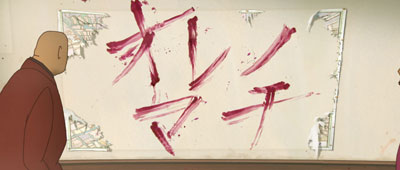
Another largely scaled back element is the soft sense of reality in Treasure Town. The movie is still driven by poetic visions and dark delusions. There are still alien people and places. But, the anime pairs down the bizarro street gangs, takes the alligators out of the sewer and the fish-man playing the blues on a shamisen out of the strip club. Thee movie does reinforce a sense of Treasure Town as a unique, imagined locale that at the same time stands in for real places with real people. As the final song from British electronica duo Plaid fades out after the end credits, there is a murmur of what corporate policy uncharitably refers to as "pink noise." That human echo puts the final stamp on the movie's presentation of a city with its own organic feel, with people rushing through its veins and artifacts built up like a coral reef. What establishes the Matsumoto and the Arias visions of Treasure Town as the ultimate urban landscape is its showcase of an omnicultural mash-up. Rather than any dominant colonization, the pre-Kiddie Kastle district lacks a McDonalds and a Star Bucks on any corner. Instead, it seems like every shop, billboard and ornament cropped up independently. Kitsch and religious iconography stands side by side. It's a dazzling concept, made more impressive with the exacting care taken to construct and animate it for the movie. The animation carries that human emphasis with a rough verite. Even in a raven's eye overview of the city, there is a natural randomness in the pattern. As a character moves, the shape of their form, the repositioning of their body and the angle in which it is captured becomes personal rather than simple or obvious. The movie's cast draws heavily from live action actors, including Kazunari Ninomiya (Letters From Iwo Jima) as Black and Yuu Aoi (the live action Honey and Clover, Hula Girls, and the live action Mushishi) as White, such that even the voices circumvent an anime formality. 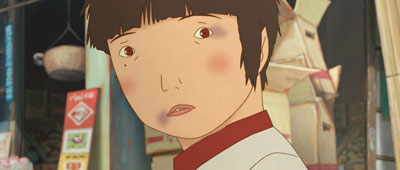
One of the expressions of anime fandom has been for fans to edit together music videos, generally popular anime cut to popular music. This tends to produce painful quantities of Naruto clips set to Nickelback, but putting aside copyright and aesthetic concerns for a moment, this is an arena that does offer an interesting gage to the reaction towards anime. Studio 4°C's previous movie effort, Mind Game, provoked a mash-up to Queen's Don't Stop Me Now. In the case of Mind Game, you had a movie that dealt with strong emotional touch points. Who doesn't get worked up when dealing with junctures in life that branch off into distinct routs? Comparing Mind Game to Tekkon Kinkreet is not entirely fair to the creators involved, but it is working on the not entirely superficial grouping of "daringly animated movies to come out of Studio 4°C." One point where Mind Game and Tekkon Kinkreet branch is that you're not going to get an up-tempo, emotions raising fan-video out of Tekkon Kinkreet. Tekkon Kinkreet is a heart felt movie. It does establish an empathy with its leads. Yet, it doesn't suggest getting jazzed up to watch Black and White fight the good fight. On one side, there's a rough story of survival. In on the other, the protagonists are engaged with a topic that provokes ambivalence. The antagonists aren't exactly paving over paradise to put up a parking lot. You arrive at the question of the ethics of urban planning and specifically, destroying a slummy community. Even when they pull down a shopping arcade or park with some organic beauty, it provokes the question as to whether the sacrifice is worth while if it makes lives easier or it create jobs. There isn't a one-to-one equating of the community with the Yakuza, but, the gangster life does serve as a backdrop for many of the movies events. As in something like the Sopranos, the movie does show a capacity for compassion in the gangsters. There is a dimension where they are taking care of their own. Watching strippers feed their children backstage is a sweet family moment. But there is also an unromanticized viciousness in which they intimidate, maim or kill the people who cross them. The aliens enter this environment with the opposing force of corporate capitalism. To project some extra-movie experience, the benefit of that system is the fruits of productivity. Particularly the Things... like DVDs. What the movie does show, in an exaggerated form, is the publicly traded company system of ethics, where treating employees as anything other than assets is practically criminal. Given the choice of someone who'd shed a tear when they shoot you or someone who'd check a box on an asset accounting sheet, your given violence and sentimentality or cold commerce. 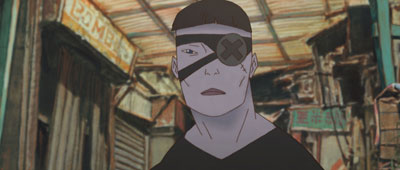
clip 2 - CHILD clip 3 - FRIEND clip 4 - PARK clip 5 - PROCESS (BTS) clip 6 - SAD clip 7 - THREE 